#EDIT: HOLY SHIT THEY WON WE CAN HAVE OUR DREAM MATCH
Explore tagged Tumblr posts
Text
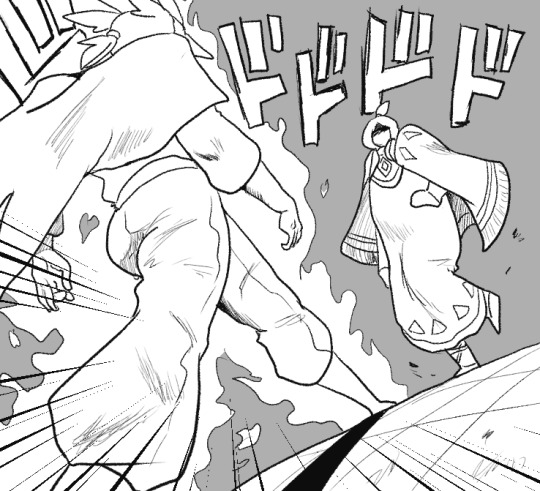
Manifesting the ultimate match of my dreams: Performance vs Grandma
I can't be the only one who imagines these matchups as a shounen anime tournament arc, right??
@bestestspirit
#sky cotl#sky children of the light#sky children of light#performance guide#belonging guide#belonging grandma#sky grandma#I could've done this with cannoneer cuz thats how it feels like right now but the mental image with grandma came first so I'm doing that#no matter who wins tho I'm just happy grandma will be at the finals tehe#EDIT: HOLY SHIT THEY WON WE CAN HAVE OUR DREAM MATCH#btw grandma sweep she deserves to annihilate them I'm sorry performance guide
431 notes
·
View notes
Text
EVENT BATTLE 2017: DC’s DARK NIGHTS: METAL vs MARVEL’s SECRET EMPIRE
I know I said that this would be an annual thing, and I’ll try to keep this on schedule, and I’ll try to post these on time, and I know I’m posting the one for 2017 as 2018 comes to an end… but writing this took a backseat as I had to finish some projects and write a thesis. C'est la vie, as the French say.
Welcome to EVENT BATTLE 2017, ladies and gentlemen. Thank you for sticking around.
Last time we had what I called a Triple Threat Match: DC vs Marvel vs Valiant. While I was hoping this would be a trend going forward, Valiant Comics took a break from publishing big summer crossover events this year. They’ll be back for the 2018 edition of Event Battle, though. (Side note: I absolutely adore Valiant’s quality over quantity strategy, and I hope it continues despite the recent setbacks.)
So, back to the heavyweights, then?

2017 saw DC Comics handing over their universe to the most successful team off their New 52 experiment, Scott Snyder and Greg Capullo (of the Batman fame), in the form of METAL, or Dark Nights: Metal. While Metal is indeed a continuation of Snyder and Capullo’s run on Batman, it does build itself up on the shoulders of giants. Peter Milligan and Kieron Dwyer’s “Dark Knight, Dark City” being one, Grant Morrison’s seminal run on Batman, Final Crisis, his The Multiversity stuff, and pretty much the entirety of his DC output is some of the few important stories from the past that the creators wove into theirs. However, although Metal leans on and borrows from a lot of stories (like most modern superhero stories do), it does not make them a required reading. You will easily find your way if you have never read “Dark Knight, Dark City” (you should, though) and don’t know who or what Barbathos is. Metal is that accessible to new readers. If you are a long-time reader and know your comics, however, it is oddly satisfying when you catch a reference.
Like I mentioned earlier, Metal brings back Barbathos, the bat daemon occultists in 1776 (including the third President of the United States of America!) tried summoning with their “Ceremony of the Bat”. Bruce Wayne, because of his connection to both the Wayne family and, well, I guess, bats in general, is revealed to be the host for Barbathos’ return. To act as the portal/host for the daemon, Wayne needs to be exposed to five divine metals. It is revealed later that Batman already has been exposed to most of them in previous storylines (Electrum in “Court of Owls”, Dionesium in “Endgame”, Promethium in “Superheavy”, Nth Metal in the prologue of the event with Dark Nights: Casting and Dark Nights: Forge , and finally, Batmanium during the course of this story). The daemon, of course, has evil intentions. It is bringing with itself the “dark multiverse”. It literally wants to sink the Earth and flip the scales.
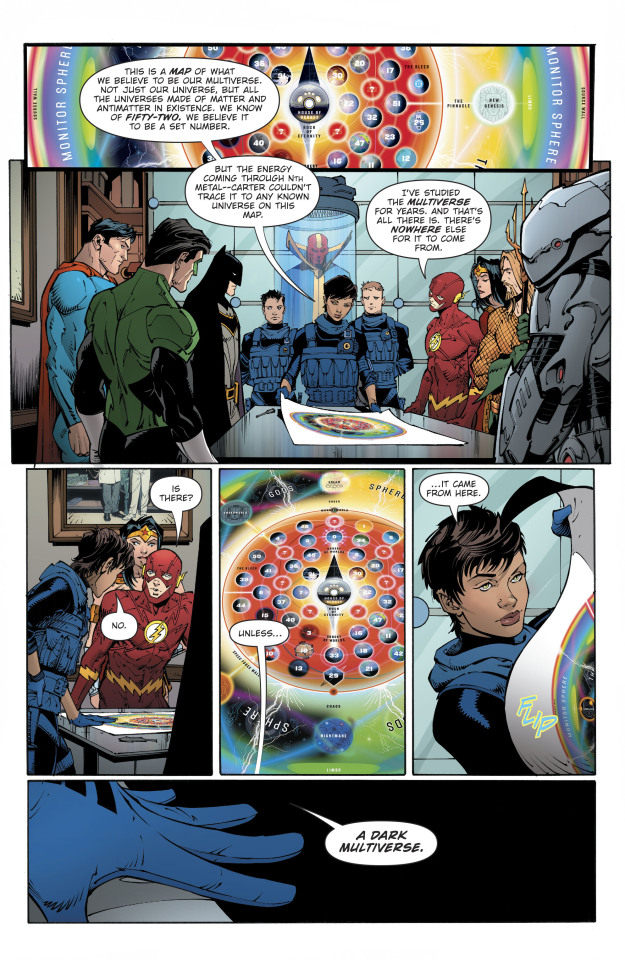
Oh, and also, it is bringing with itself the twisted versions of Batman… who kinda do look awfully similar to Dark Judges from Judge Dredd?
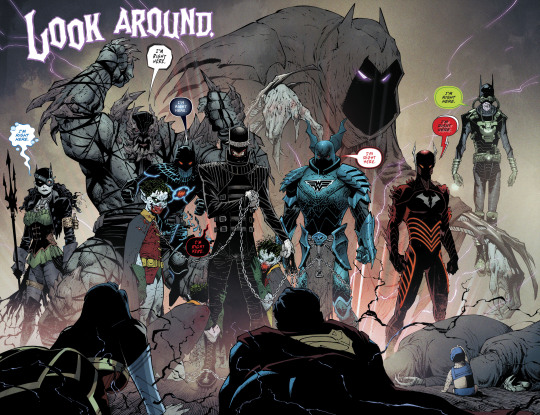
As you can imagine, much of the story then follows Batman and the Justice League’s attempt at stopping Barbathos and his horde of mercenaries. Metal is filled to the brim with ridiculously absurd and deliciously fun moments throughout. While I did stick with my rule of not reading the tie-ins for events, I did read those that Snyder co-wrote, and they work quite well with the main story. They offer details to the story as you would expect from a tie-in but if you do choose to follow the main book only, you would be good.
While bigger, louder, more ridiculous seems to Snyder’s modus operandi for every story after “Zero Year”, it just kinda works here. Rarely does the story pauses and the characters get a chance to breathe. Even the dialogues are written in such a way that they service the plot forward and not add any depth to the characters themselves. While this does seem to continue on his Justice League run, what I do appreciate here is how he managed to adapt and extend previous stories and add more layers to the cosmic side of the DC Universe, which I have always felt falls a bit short when compared to Marvel. Apart from Darkseid and the New Gods, there’s not much else to it, is there? (Cue fans telling me off in 3… 2… 1…)
Greg Capullo draws every issue of Metal, front to back. This in itself is unheard of for modern superhero crossover events, but that’s not all. The man knocks it out of the park throughout. From huge action splash pages to an eight panel page of a tightly choreographed fight scene, Capullo works his magic throughout. Joining him on the tie-ins are John Romita Jr., Andy Kubert, Jim Lee, Doug Mahnke, Yanick Paquette, Jorge Jiménez, Riley Rossmo, Howard Porter, Bryan Hitch, Mikel Janín, and a host of talented inkers and colourists. While on some scenes in the tie-ins, the transitions between the artists is not subtle and it feels a bit off, the books are a sight to behold. If Jorge Jiménez’s work on Superman, Super-Sons, etc. didn’t inform you, the guy is a superstar.

Marvel, on the other hand, had a rough year. I’m talking about the comic book side of the business, of course. They seem to be doing just fine everywhere else.
SECRET EMPIRE is the continuation of Nick Spencer’s Captain America run, specifically his ‘Hydra Cap’ storyline. You know, the one that caused so much outrage. I wasn’t following his run then, but reading this event now, I learnt that (spoiler alert:) that man is that controversial panel actually is Steve Rogers. While the story very firmly establishes that it is not an LMD, not a clone, not a shape-shifter, etc., that man is still not our Captain America. Something is a bit off – specifically, Rogers gets his history rewritten by a sentient cosmic cube – and this leads to an interesting “What If?” storyline, almost.
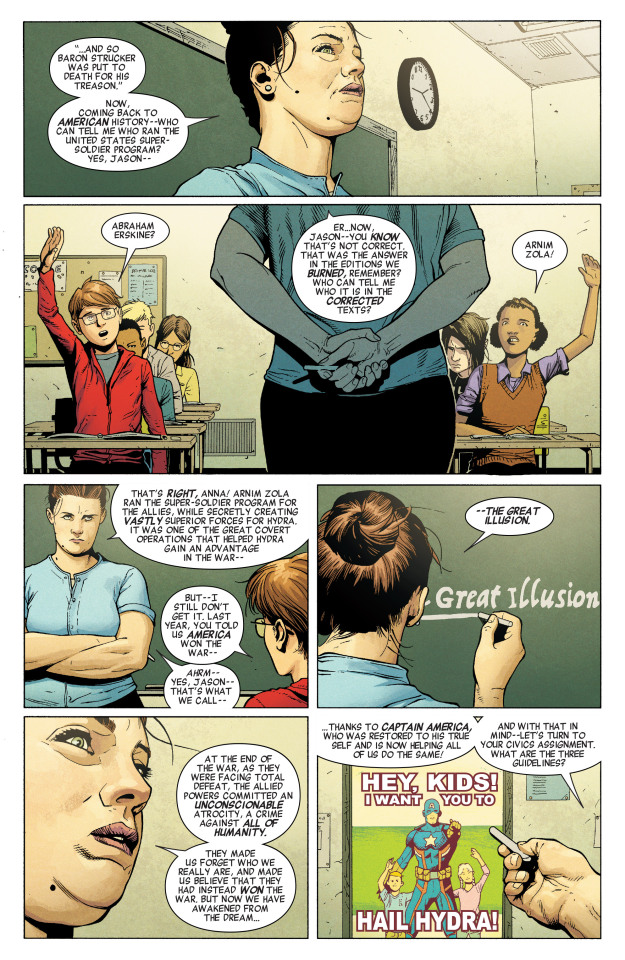
Yes, Captain America is a Hydra agent. The bad guys have won. America is under Nazi rule (Which, is not that different from the current state of things, is it?). Spencer’s plays with this idea throughout the story, drawing parallels between the two. For example, the persecution of the Inhumans in the make-believe world is drawn from the persecution of the Jews in the real, and so on. While the story is not that epic in scale as Metal perhaps is, it does work as a summer blockbuster crossover event story regardless. Spencer also smartly limits the active cast. New York is put under a blackout, so half the Marvel superheroes are off the table and a shield around Earth has locked out heavy-hitters like Captain Marvel and such. This makes it easier to follow the action. Not that I doubt Spencer’s ability to write a large cast (he does exactly that so expertly here) or that I doubt the reader’s ability to read a book with a large cast. A smaller cast works here, because unlike Metal, for example, this is not a story about the heroes trying to stop the bad guys from winning. They have won already. It is up to a handful of rebels to overthrow the regime Reich.
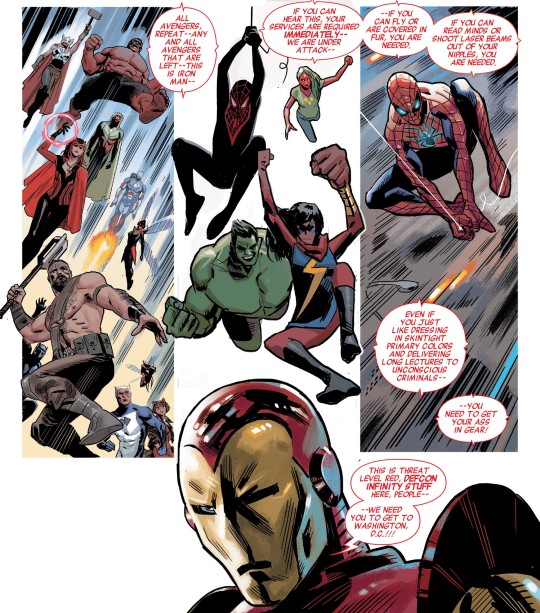
The first and the last issue of the story is drawn by Steve McNiven, and rest of the work is divided among Rod Reis, Daniel Acuña, Andrea Sorrentino, Joshua Cassara, Leinil Francis Yu, Sean Izaakse, Joe Bennett, Ron Lim, Paco Medina, …holy shit that’s a lot of artists. To their credit though, the editorial team does manage to avoid any art inconsistencies. The story follows the one artist per issue rule to the dot, or a specific artist(s) sticks with a particular plotline. Steve McNiven hyper-detailed art sets up the mood perfectly in the beginning and that exposition is perfect for the end. Andrea Sorrentino, I think, handles a major portion of the book. His panel structure and innovative use of the borders and the gutters is fantastic.

THE VERDICT
To be honest, this was the hardest it has been in quite some time to pick one of the two. Usually, I like one book over the other a lot. Infinity over Forever Evil, Original Sin over Futures End, Secret Wars over Convergence, Rebirth over Civil War II and 4001 A.D. This year, I thought both worked quite well in their own regard. Neither of them is perfect by any means. There are some gaping holes in the plot of both stories. Dream appearing in Metal to add a convenient layer of exposition to an ‘oh my god, how are they ever going to do it?’ plot, The Punisher and Thor kinda turning Nazis with little to no conviction in Secret Empire, and so on. Nonetheless, I had a good time reading them, and that’s all that matters on some days.
While both Metal and Secret Empire had some lasting impact in their respective universe, most of what was caused by Secret Empire has been hushed over. This is partially, I think, because of all the (unnecessary) outrage it caused. Metal, on the other hand, boosted sales, launched new series, spun new tales. I had so much fun reading that book. And oh, how could I ever forget baby Darkseid doing the devil’s horns?

#marvel#DC comics#event battle#metal#dark nights metal#secret empire#hydra cap#baby darkseid#scott snyder#Greg Capullo#nick spencer#steve mcniven#andrea sorrentino#rod reis#dark knight dark city#grant morrison#peter milligan
1 note
·
View note